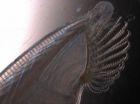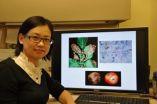(Press-News.org) WOODS HOLE, MASS. -- Among the animals that are appealing "cover models" for scientific journals, lancelets don't spring readily to mind. Slender, limbless, primitive blobs that look pretty much the same end to end, lancelets "are extremely boring. I wouldn't recommend them for a home aquarium," says Enrico Nasi, adjunct senior scientist at the Marine Biological Laboratory (MBL). Yet Nasi and his collaborators managed to land a lancelet on the cover of the Journal of Neuroscience last December. These simple chordates, they discovered, offer insight into our own biological clocks.
Nasi and his wife, MBL adjunct scientist Maria del Pilar Gomez, are interested in phototransduction, the conversion of light by light-sensitive cells into electrical signals that are sent to the brain. The lancelet, also called amphioxus, doesn't have eyes or a true brain. But what it does have in surprising abundance is melanopsin, a photopigment that is also produced by the third class of light-sensitive cells in the mammalian retina, besides the rods and cones. This third class of cells, called "intrinsically photosensitive retinal ganglion cells" (ipRGCs), were discovered in 2002 by Brown University's David Berson and colleagues. Now sometimes called "circadian receptors," they are involved in non-visual, light-dependent functions, such as adjustment of the animal's circadian rhythms.
"It seemed like colossal overkill that amphioxus have melanopsin-producing cells," Nasi says. "These animals do nothing. If you switch on a light, they dance and float to the top of the tank, and then they drop back down to the bottom. That's it for the day." But that mystery aside, Gomez and Nasi realized that studying amphioxus could help reveal the evolutionary history of the circadian receptors.
As so it has. In 2009, Gomez and Nasi isolated the animal's melanopsin-producing cells and described how they transduce light. In their recent paper, they tackled the puzzling question of why the light response of these amphioxus cells is several orders of magnitude higher than that of their more sophisticated, presumed descendents, the ipRGCs. (In mammals, the ipRGCs relay information on light and dark to the biological clock in the hypothalamus, where it is crucial for the regulation of circadian rhythms and associated control of hormonal secretion.)
By detailing how the large light response occurs in the amphioxus cells, Gomez and Nasi could relate their observations to the functional changes that may have occurred as the circadian receptors evolved and "eventually tailored their performance to the requirements of a reporter of day and night, rather than to a light sensor meant to mediate spatial vision." The light-sensing cells of amphioxus, they discovered, may be the "missing link" between the visual cells of invertebrates and the circadian receptors in our own eyes.
INFORMATION:
Citations
Ferrer C., Melagón G., del Pilar Gomez M., and Nasi E. (2012) Dissecting the Determinants of Light Sensitivity in Amphioxus Microvillar Photoreceptors: Possible Evolutionary Implications for Melanopsin Signaling. J. Neurosci. 32: 17977-17987.
del Pilar Gomez M., Angueyra J.M, and Nasi E. (2009) Light-transduction in melanopsin-expressing photoreceptors of Amphioxus. PNAS 16: 9081-9086.
The Marine Biological Laboratory (MBL) is dedicated to scientific discovery and improving the human condition through research and education in biology, biomedicine, and environmental science. Founded in 1888 in Woods Hole, Massachusetts, the MBL is an independent, nonprofit corporation. A corps of more than 270 scientists and support personnel pursue research year-round at the MBL, joined each year by more than 400 visiting scientists, summer staff, and research associates from hundreds of institutions around the world. Among the scientists with a significant affiliation with the MBL are 55 Nobel Laureates (since 1929).
Sensing the light, but not to see
MBL study offers insight on the evolution of photsensitive cells
2013-02-07
ELSE PRESS RELEASES FROM THIS DATE:
Scientists identify genetic mechanism that contributed to Irish Famine
2013-02-07
RIVERSIDE, Calif. — When a pathogen attacks a plant, infection usually follows after the plant's immune system is compromised. A team of researchers at the University of California, Riverside focused on Phytophthora, the pathogen that triggered the Irish Famine of the 19th century by infecting potato plants, and deciphered how it succeeded in crippling the plant's immune system.
The genus Phytophthora contains many notorious pathogens of crops. Phytophthora pathogens cause worldwide losses of more than $6 billion each year on potato (Phytophthora infestans) and about ...
The deep roots of catastrophe
2013-02-07
SALT LAKE CITY, Feb. 7, 2013 – A University of Utah seismologist analyzed seismic waves that bombarded Earth's core, and believes he got a look at the earliest roots of Earth's most cataclysmic kind of volcanic eruption. But don't worry. He says it won't happen for perhaps 200 million years.
"What we may be detecting is the start of one of these large eruptive events that – if it ever happens – could cause very massive destruction on Earth," says seismologist Michael Thorne, the study's principal author and an assistant professor of geology and geophysics at the University ...
2 antibodies are better than 1
2013-02-07
Cancer drugs of the new, molecular generation destroy malignant breast tumors in a targeted manner: They block characteristic molecules on tumor cells - receptors for the hormones estrogen or progesterone, or a co-receptor, called HER2, that binds to many growth factors. But about one in every six breast tumors has none of these receptors. Such cancers, called triple-negative, are particularly aggressive and notoriously difficult to treat.
Some of these therapy-resistant cancers have a potential molecular target for cancer drugs, a growth-factor receptor called EGFR, ...
A genetic device performs DNA diagnosis
2013-02-07
Scientists hope that one day in the distant future, miniature, medically-savvy computers will roam our bodies, detecting early-stage diseases and treating them on the spot by releasing a suitable drug, without any outside help. To make this vision a reality, computers must be sufficiently small to fit into body cells. Moreover, they must be able to "talk" to various cellular systems. These challenges can be best addressed by creating computers based on biological molecules such as DNA or proteins. The idea is far from outrageous; after all, biological organisms are capable ...
Going along means getting along -- and that's not always good, Baylor study finds
2013-02-07
Caving in to social pressure — such as saying that you love a movie because friends do — makes for good vibes about being part of a group and can produce more of the same conduct, according to a Baylor University sociological study. The finding has implications for people ranging from philanthropists to gangs, researchers said.
"The punch line is very simple: Conformity leads to positive feelings, attachments, solidarity — and these are what motivate people to continue their behavior," said Kyle Irwin, Ph.D., an assistant professor of sociology at Baylor and lead author. ...
Observed: The outburst before the blast
2013-02-07
Before they go all-out supernova, certain large stars undergo a sort of "mini-explosion," throwing a good-sized chunk of their material off into space. Though several models predict this behavior and evidence from supernovae points in this direction, actually observations of such pre-explosion outbursts have been rare. In new research led by Dr. Eran Ofek of the Weizmann Institute, scientists found such an outburst taking place a short time – just one month – before a massive star underwent a supernova explosion.
The findings, which recently appeared in Nature, help ...
How to improve communication between parents and children after divorce
2013-02-07
How to improve communication between parents and children after divorce
Article provided by Law Office of Rebecca Garren Parker Visit us at http://www.rebeccaparkerlaw.com
Most people understand that divorce takes a toll on the finances and emotions of a family. However, some may not realize the burden a divorce can place on communication between family members, including communication between former spouses and between parents and children. By following a few simple tips, everyone can improve communication and help redefine and heal relationships after a divorce.
Communication ...
How parenting plans work in California
2013-02-07
How parenting plans work in California
Article provided by The Law Offices of Daniel S. Frank Visit us at http://www.danielfrankattorney.com
A parenting plan, also called a custody and visitation agreement, is a written agreement that where and with whom the child of divorcing parents will and defines the times the child will spend with the non-custodial parent. The main purpose of creating a parenting plan is to agree on how to share time with the child and how the parents will make important decisions regarding the child's welfare, such as education and health. ...
Credit Can Be Restored After Bankruptcy
2013-02-07
Credit Can Be Restored After Bankruptcy
Article provided by Mitchell & Malone Visit us at http://www.mitchellmir.com
In a tough economy, Texas families may find themselves with more debt than they can handle. Filing for bankruptcy is a workable solution for many Texans, but along with the relief that comes with managing debt may come worries about the long-term financial effects of bankruptcy.
Some of those worries are not well founded. In particular, a bankruptcy filing need not permanently ruin a filer's credit, even though the bankruptcy will remain in a ...
California employers gain more control over workplace injury care
2013-02-07
California employers gain more control over workplace injury care
Article provided by Atcheson & Kepler Visit us at http://www.workinjury-sandiego.com
Residents of San Diego and other areas in California might be aware that a change in state policy makes a new form of treatment option available to employers in the event of an injury connected to a workers' compensation claim. It may be helpful for employees to be aware of these changes and the implications that they have in terms of medical care provided to injured employees.
What is a medical provider network?
Several ...
LAST 30 PRESS RELEASES:
Making lighter work of calculating fluid and heat flow
Normalizing blood sugar can halve heart attack risk
Lowering blood sugar cuts heart attack risk in people with prediabetes
Study links genetic variants to risk of blinding eye disease in premature infants
Non-opioid ‘pain sponge’ therapy halts cartilage degeneration and relieves chronic pain
AI can pick up cultural values by mimicking how kids learn
China’s ecological redlines offer fast track to 30 x 30 global conservation goal
Invisible indoor threats: emerging household contaminants and their growing risks to human health
Adding antibody treatment to chemo boosts outcomes for children with rare cancer
Germline pathogenic variants among women without a history of breast cancer
Tanning beds triple melanoma risk, potentially causing broad DNA damage
Unique bond identified as key to viral infection speed
Indoor tanning makes youthful skin much older on a genetic level
Mouse model sheds new light on the causes and potential solutions to human GI problems linked to muscular dystrophy
The Journal of Nuclear Medicine ahead-of-print tip sheet: December 12, 2025
Smarter tools for peering into the microscopic world
Applications open for funding to conduct research in the Kinsey Institute archives
Global measure underestimates the severity of food insecurity
Child survivors of critical illness are missing out on timely follow up care
Risk-based vs annual breast cancer screening / the WISDOM randomized clinical trial
University of Toronto launches Electric Vehicle Innovation Ontario to accelerate advanced EV technologies and build Canada’s innovation advantage
Early relapse predicts poor outcomes in aggressive blood cancer
American College of Lifestyle Medicine applauds two CMS models aligned with lifestyle medicine practice and reimbursement
Clinical trial finds cannabis use not a barrier to quitting nicotine vaping
Supplemental nutrition assistance program policies and food insecurity
Switching immune cells to “night mode” could limit damage after a heart attack, study suggests
URI-based Global RIghts Project report spotlights continued troubling trends in worldwide inhumane treatment
Neutrophils are less aggressive at night, explaining why nighttime heart attacks cause less damage than daytime events
Menopausal hormone therapy may not pose breast cancer risk for women with BRCA mutations
Mobile health tool may improve quality of life for adolescent and young adult breast cancer survivors
[Press-News.org] Sensing the light, but not to seeMBL study offers insight on the evolution of photsensitive cells


